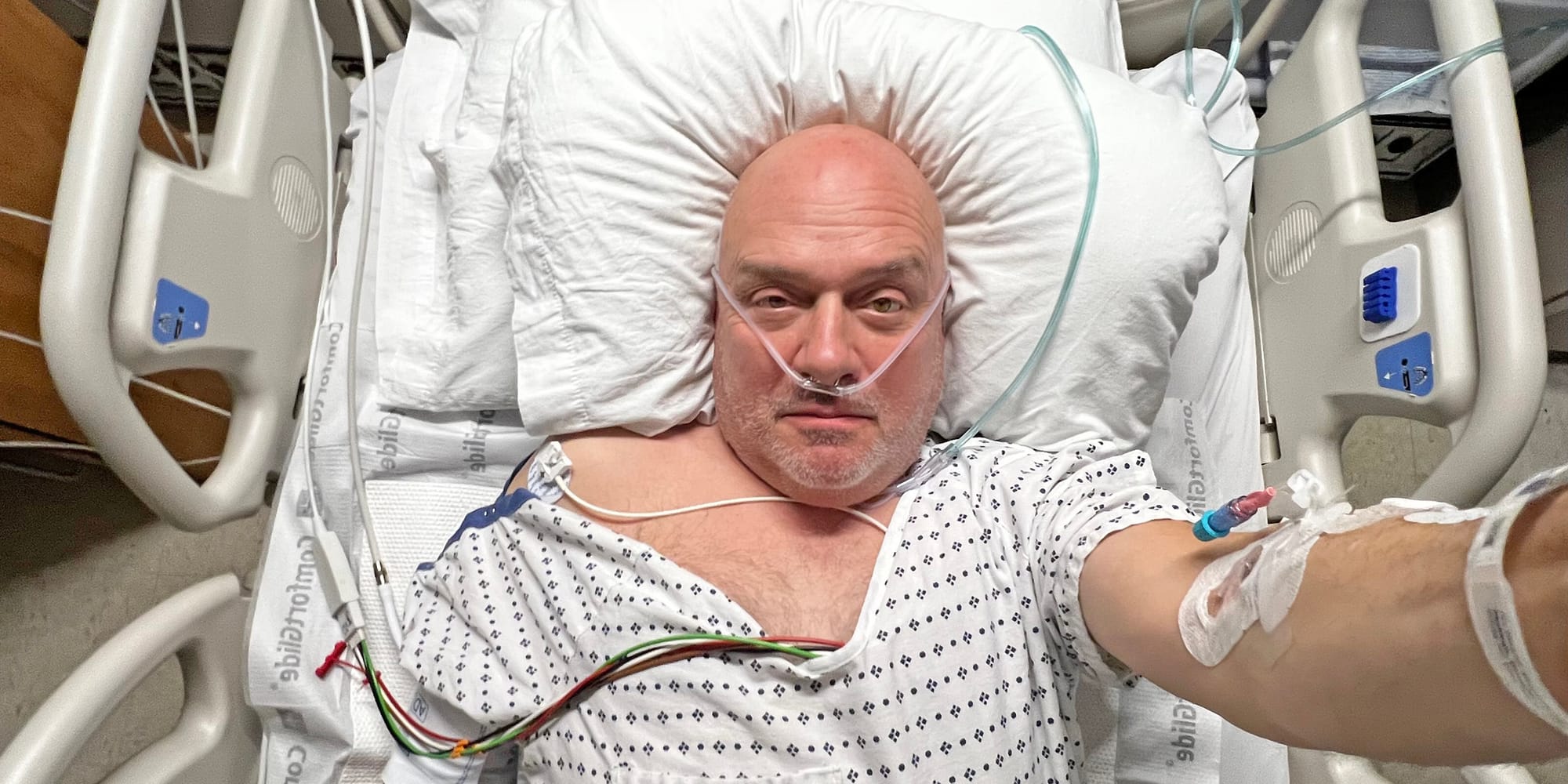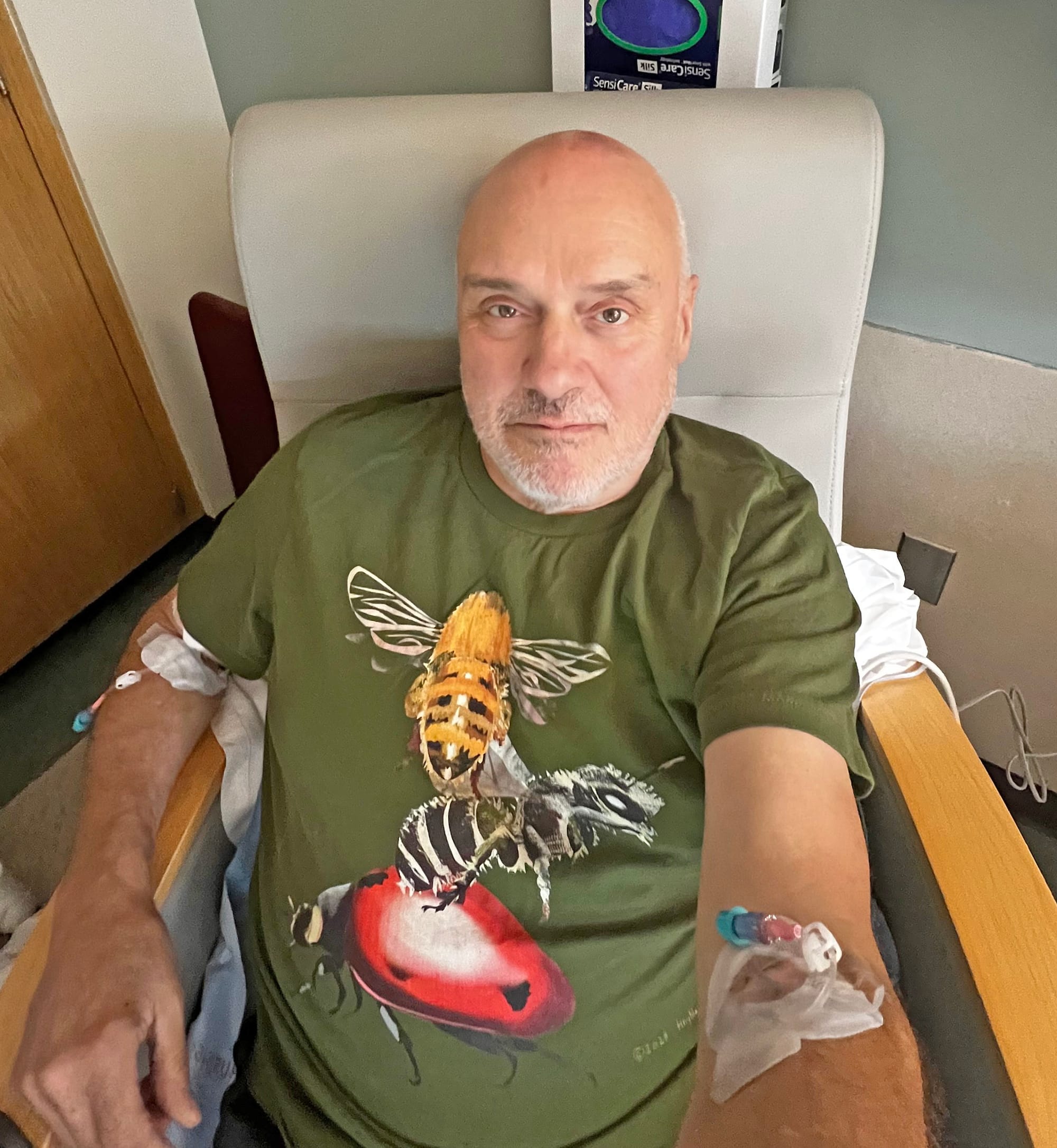Struck by lightning

This week hasn't gone as planned. Well, Monday went as planned – Nancy and I took the spectacular hike up to Highland Lookout – but that evening things started heading in an unexpected direction that led to me posting this from Saint James Hospital five days later. This post is to let everyone know what's been going on.
The short version: on Tuesday, I went into the ER with a very swollen and painful right knee (the one that was replaced in May), and it turned out to be a rapidly growing staph infection. I had surgery on Wednesday to clean the knee out, and it went well but I was in the ICU overnight after surgery because of sepsis concerns. I survived the night, and by Thursday I was improving and have felt steadily better through Thursday, Friday, and Saturday. I'll probably get out of the hospital on Monday, with a PICC line installed so that I can give myself IV antibiotics for six weeks, then oral antibiotics for a year to reduce the risk of recurrence. There's no way to ever know what caused this – most likely a scratch on my skin, and some bacteria got into the bloodstream through that. Hug your loved ones, life is fragile. And I am grateful for how this played out.
And here's a longer version of the last five days:
Monday, Nancy and I drove up to the Highlands Lookout trailhead and took our hike. My knee was feeling a bit stiff and sore as we started out, but I've taken several hikes this summer (including this same one, with Isaac), and usually any stiffness at the beginning disappears after I get warmed up. That didn't happen this time. It got steadily more painful throughout the day, and when we got home I was limping. I carefully put all my weight on that leg and raised and lowered my body, and that didn't increase the pain – I think the pain actually went down when I did that. So I figured the joint wasn't injured, and I popped some Tylenol and iced it. But nothing seemed to reduce the pain, and the swelling was growing. That night was miserable, and even with oxycodone at midnight the pain kept me awake until after 5AM, then I finally slept a couple of hours.
Tuesday, I woke up with a throbbing swollen leg, but there was no redness. I knew redness could mean an infection in the joint, so that seemed reassuring. I tried putting ice on it for a while, but soon my knee was starting to turn a reddish tint, so we decided it was time to head to the ER. At this point I couldn't put any weight on it at all, and every movement was brutal, so getting me to the hospital was a chore, even thought it's less than a mile away.
At the ER, they did bloodwork and x-rays and it was clear that I had an infection. My white blood cell count and other infection markers were all elevated, and the redness and swelling were rapidly growing. They put me on IV antibiotics, and I've now been on IV antibiotics for five days since then.
I met with an orthopedic surgeon named Dr. Stenger, and we discussed options. With the magnitude and rapid growth of the swelling, he felt we needed to open up the knee joint to get it cleaned out ASAP, and not wait two days for blood cultures to come back (which would likely identify exactly what type of infection it was, to help plan the best possible treatment). Waiting could allow the infection to get under the implants, which would require total removal of the knee joint to clean it out, or worst case lead to sepsis, which can be fatal.
So they put a 3 inch needle into the center of my knee and drained some fluid (nearly 50ml) to provide a little temporary relief, and then transferred me to a hospital room for the night. The nurses checked on me hourly, to get my vital signs and make sure the IV antibiotics were flowing, and we planned to do the surgery as soon as possible on Wednesday.
Wednesday, Dr. Stenger had an urgent surgery scheduled in the morning that ran long, then another life-threating situation to deal with. For those reasons and some others, we didn't get me into the operating room until late afternoon.
By that time, I had regained the 50ml swelling they had removed plus a lot more, and the redness had started extending up and down my leg. I also had a growing fever with chills, and (as they told me the next day) I was growing slightly incoherent. These are all possible signs of heading into sepsis/septic shock, so they were getting pretty concerned about me.
Just before 5:00 Wednesday, they wheeled me into the operating room. A knee cleanout procedure like this normally takes around 90 minutes, but mine went well over two hours because of how much the infection had grown, and because they went to great lengths to try to get it 100% removed.
NOTE: I know the details in the following paragraphs because later in the week I met with a PA who was in the operating room throughout the procedure. I was sedated, thankfully.
After carefully re-opening the incision from my knee replacement in May, they were surprised at how big the infection was around my knee, and immediately got to work on getting rid of it. First, they took out the polyethylene spacer inside the joint. Next, they removed a bunch of scar tissue from the original knee replacement surgery. ("Don't worry," Dr. Stenger told me the next day, "you'll grow most of that back.") Then they methodically disinfected and scrubbed the implants in my tibia and femur, the ends of the bones and all the soft tissue in the area. Then they replaced the polyethylene insert with a new disinfected one of the same specifications, and sewed me up.
That also checked the implants for how secure they were. The surgeon tapped on them with a hammer and saw no motion or vibration. He praised the work of my original surgeon, which was nice to hear.
My blood pressure dropped significantly throughout the surgery, which is unfortunately another possible marker for septic shock. So instead of putting me in a recovery room, they put me in the Intensive Care Unit (ICU) overnight, where I could be closely monitored.
Thursday, I woke up in the ICU. I was in a lot of pain, more than after the original knee replacement, and apparently this is common. Disinfecting and scrubbing all of that bone and soft tissue can hurt more than just cutting off the ends of the bones and installing implants.
Both Dr. Stenger and the anesthesiologist dropped in to see me before before 7AM, despite the late hour of my surgery the night before, and Dr. Stenger had some great news: my white blood cell count was already back to normal, indicating that they had succeed in removing all of the infection.
I hung out in the ICU until mid-morning, when a room opened up on the 3rd floor, where I've been ever since. Shortly after I got to my room, a physical therapist showed up to take me for a walk with a walker. After three joint replacements prior to this procedure, I'm familiar with the thinking behind getting a surgical joint in motion and bearing weight as soon as possible after surgery, to maximize healing and future range of motion, but this was my most painful PT experience ever. It took multiple attempts to get up to a seating position on the edge of the bed, and then multiple attempts to stand up on my good leg, and then I managed to slowly shuffle across the ten feet to the door and back, gasping in pain the whole time.
We took two more walks in Thursday, and each one was a little better than the one before.
Friday, I woke up with less pain than any morning all week. A good sign.
A PA from the orthopedic team came by, a guy I had never met before. He had been in in the operating room throughout my surgery, assisting Dr. Stenger, and he told me some details of the surgery.
He also removed the drain that had been in the right side of my knee since surgery. It was a goosebumpy feeling of relief when he slid out the long needle, and then he methodically squeezed and massaged the area around my knee to expunge the last of the fluid before sealing it up with a waterproof bandage.
After that, I met with Dr. Pullman, the infectious diseases expert. He had gotten back the blood cultures of the fluid they had drained from my knee Tuesday night, and it was positive for staphylococcus aureus. So he knew exactly what was the source of my infection, and he had a plan for addressing it.
Staphylococcus aureus is a germ found on the skin and in the noses of about 30% of individuals. It's harmless when it sits in those places, but if you have a small cut or scratch it gets into, it can travel directly into your bloodstream and then to any part of your body. That's probably how I got this staph infection, but we'll never know for sure.
I asked Dr. Pullman what I could have done to reduce the risk of this infection. "Nothing," he said, "you just got struck by lightning."

My pain situation has been steadily improving the last 48 hours – I needed multiple doses of Dilaudid to get to sleep Wednesday night (oxycodone and morphine weren't enough), then got through Thursday night with just one Dilaudid and a couple of doses of oxycodone, then got through Friday night with just one oxycodone and a couple of doses of Tylenol.
Another sign of my improvement this week: Tuesday and Wednesday night the nurses were checking on me hourly, Thursday night every two hours, and Friday night every four hours. At one point Friday night I found myself laying in bed thinking "what does a guy have to do to get a drink around here?"

Added one week later ...
I've been home a few days now, and have settled into the routine giving myself IV antibiotics three times per day, which I'll be doing for six weeks. Here's video of the process:
IV antibiotics at home. The whole process takes 7-8 minutes, and this video is at 5X speed.